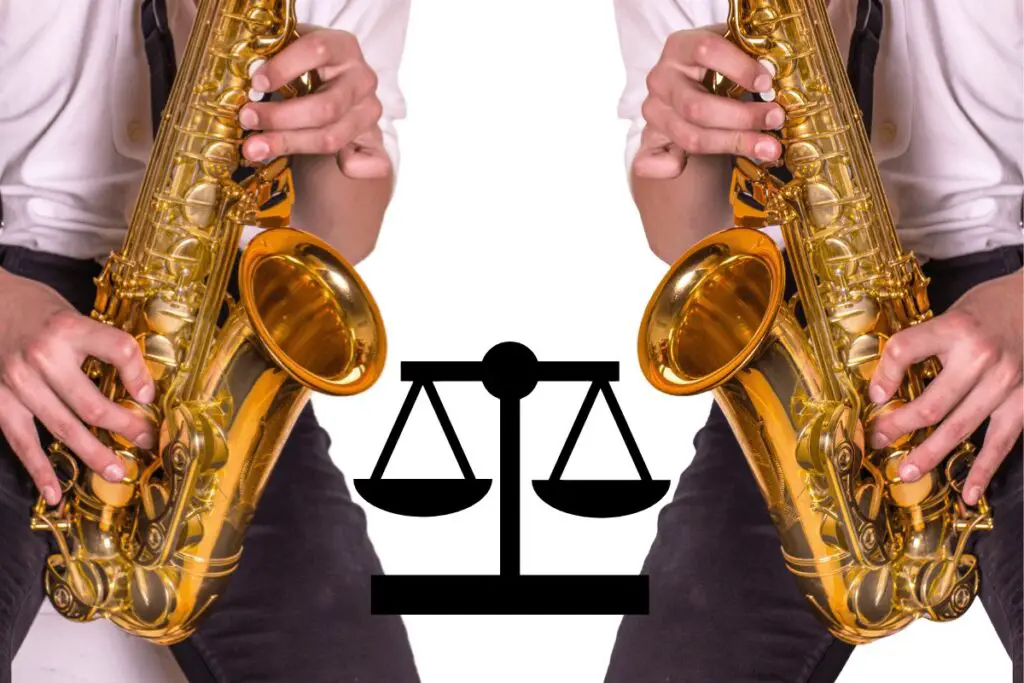The saxophone is one of the most popular band instruments out there, and many people get excited about learning it.
But as people look into it, they get confused about the two main types of saxophones: the alto and the tenor.
As a music teacher, I’m often asked about them and which one is better for this or that.
Today, I decided to tackle this topic with a detailed tenor vs. alto sax comparison.
The alto and tenor saxes are great instruments for beginners and jazz. The alto is a more common starter, while the tenor seems more popular with skilled players. The alto plays higher and is smaller than the tenor who plays lower.
There’s a lot more to these two instruments than what I just said, so read on for more details (including video examples of the two).
Table of Contents
Alto Or Tenor Sax For Beginners: Which Is Better?
The alto is a little better for beginners because it’s smaller, easier to handle, and requires less air. Both tenor and alto have a lot of resources for new players and are among the easiest instruments to start on.
Take a look at this table to directly compare the two regarding beginners and new players.
Use the information to help you decide which is right for you.
| Quality | Alto Saxophone | Tenor Saxophone |
|---|---|---|
| Creating sound | Very easy | Very easy |
| Size | Medium-small | Medium |
| Holding | Very easy | Easy for most, hard for smaller kids |
| Fingering | Easy | Easy for most, hard for small hands |
| Cost | Moderate to affordable | Moderate |
| Helpful resources | Many resources for all levels | Many resources for all levels but slightly less for beginners |
| Air requirement | Easy | Easy-Medium |
| Tonguing | Easy | Easy-Medium |
As the chart above shows, the alto and tenor are pretty neck and neck in almost every category as far as ease goes.
The slight difference all goes in favor of the alto saxophone, which is why most band programs require their students to at least spend a year learning the alto before switching to the tenor.
Fortunately, saxophones all use the same fingerings and a similar embouchure or mouth shape to play, so it’s easy to switch once you’ve got the basics down.
If you’re older than a middle schooler, I’d say just pick the one you want or the one you already have at home.
Both are so close in the grand scheme it won’t make a difference.
Alto Vs. Tenor Sax For Jazz
The tenor sax is the more popular jazz instrument, though the alto sax serves an almost equally important role. All saxophones are common in jazz for their ability to produce powerful sounds like brass instruments and yet also play in a mellow manner like the woodwinds.
Part of the reason the tenor is more popular with the jazz sax player comes down to its role in the ensemble.
In most jazz groups, we’ll see some of these instruments:
- Flute
- Clarinet
- Trumpet
- Alto sax
- Trombone
- Tenor Sax
- Bari Sax
- Electric bass
- Double bass
- Piano
- Drum set
Of course, any instrument can play jazz, but these are the most common (and I double-checked with my wife and other band directors to make sure I was right).
Let’s split these up into voice parts or ranges.
In the higher end, we have:
- Flute
- Clarinet
- Trumpet
- Alto sax
In the middle range, we have:
- Tenor sax
- Trombone
On the lower end, we have:
- Bari sax
- Electric bass
- Double bass
The piano goes over the whole range, and the drum set takes care of the rhythm.
The middle range has fewer instruments making the tenor the most important of the three saxes in jazz. For this reason, it gets to show off a little more and play more interesting parts than the alto, which often flips between enhancing the high or mid parts.
Both tenor and alto are still critical and popular in jazz, but the tenor usually has a bit more fun.
Tenor And Alto Sax: Direct Comparison

We’ve looked at the tenor and alto for beginners and in jazz. Let’s look at these two compared directly in each of their main elements.
Check out the later section for the videos comparing them directly.
Size
The first thing you see right off the bat is a difference in size.
Altos are smaller than tenor saxes.
Altos will weigh around 4lb 5oz on average, while the tenor weighs 6lb 4oz.
The alto is around 2’ feet 4” inches long compared to the tenor’s 3’ feet.
Bell size is different and depends on the brand and model, but the tenor is bigger than the alto.
Both have the same design, featuring a similar number of keys and the iconic J-shape.
Range, Key, And Transposing Instrument
As a smaller instrument, the alto saxophone plays in a higher range than the tenor sax.
In sounding pitch, the alto has a standard range of Db3 to Ab5.
Tenors have a sounding range of Ab2 to Eb4.
But that’s not the whole story.
Saxophones use the same fingerings and read the same notes no matter which type of saxophone it is.
How is this possible? These are transposing instruments.
This means the note they read isn’t the note they play. It sounds confusing and extra, but this is how you can switch between saxes without learning new fingerings.
An alto sax is an Eb or E-flat instrument, and tenor saxes are Bb instruments.
This means when an alto plays and fingers their C, they actually sound an Eb.
For tenors, this means when they finger the same C, it comes out as a Bb.
In the written range, both alto and tenor have the same range (though it comes out sounding different).
It looks like Bb3-F6.
Sound
The sounds of both instruments are quite similar. People use words like the following to describe them both:
- Mellower sound
- Rich sound
- Powerful
- Brassy
- Rich
- Pure
There’s no real difference in sound quality or timbre between the two. People will often confuse the range difference for sound quality.
Higher sounds tend to come across as a bit more bright, while lower sounds are considered denser.
A bigger difference comes from the type of music played by the tenor and alto.
Tenors tend to get longer but louder parts, while the altos have faster, fluttery, and complex parts.
Check out our full article on a saxophone sound description.
Difficulty
For difficulty, there’s not much difference.
Both are among the easiest band instruments to play. Both produce sound easily.
Even the air required to pay isn’t much different. You’d think because the tenor is bigger, it’d require a lot more air, but it’s not much more.
I’ve seen middle schoolers easily play the tenor, despite its larger size.
In this category, the edge goes slightly more to alto, but they’re both so easy, it really doesn’t matter.
Cost
Here the alto sax wins handily.
Because of the smaller size and higher supply, the price of alto saxophones is always far less than the tenor.
Compared directly to one another, it’s reasonable to expect a similar quality of tenor to cost more than the alto sax.
Here’s a quick look at brand new saxes and their cost by level:
- Beginner – Alto $1,000 – Tenor $2,000
- Intermediate – Alto $2,500 – Tenor $3,000
- Professional – Alto $3,000 – Tenor $4,500
Used saxophones don’t always cost this much, but the higher the level of instrument, the more value it keeps even when used.
If searching for used instruments, I’d first suggest you check a local music store.
After this, pawn shops and online saxophone forums are fine, but make sure you do your research on the original price of the model.
Avoid eBay or Facebook Marketplace unless you get help from a musician.
Tenor Sax And Alto Sax Videos
All of these descriptions and pictures are great, but sometimes you just need to see some videos of pros playing the instruments to compare them better.
In this section, I found two videos per instrument. One of the videos from each instrument is playing the same song for a better direct comparison.
The other is a video that just shows off what I think is the best quality of each sax.
Tenor Saxophone
First, we’ll look at a tenor saxophone playing the famous jazz chart, Autumn Leaves.
The first video in the alto section will be the same piece.
Start this next one around the 2-minute mark (or listen to the whole thing; it’s great!).
Here we see some tenors doing what tenors do best: Supporting and blasting some sweet solos in jazz music.
Alto Saxophone
Here is an alto sax playing Autumn Leaves. This is the same song used in the first video of the tenor sax video section.
Next is the alto playing an iconic solo from the Carnival of Vince. This solo is played by many, many instruments, but it serves to show off the alto’s ability to play with accuracy and agility.

